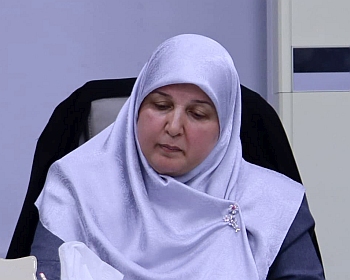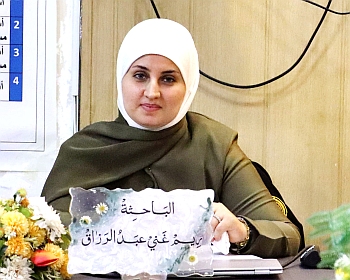
ناقش قسم الفيزياء في كلية التربية للعلوم الصرفة (ابن الهيثم) رسالة الماجستير الموسومة ” تأثير التلدين والتشويب على خصائص اغشية Cu2S الرقيقة لتطبيقات الخلية الشمسية ” للطالب ” علي عبدالله حميد ” التي انجزها بإشراف التدريسية في القسم ” أ.د. بشرى كاظم حسون.
ويهدف هذا البحث الى :
- حضير سبيكة المركب Cu2S من عناصرها الاولية لغرض الحصول على اغشية رقيقة منها بطريقة التبخير الحراري بالفراغ ودراسة خواصها التركيبية والبصرية والكهربائية.
- تأثير التشويب بمواد مختلفة Sb,Bi,Al)) وبنسبة%3 على خواص الاغشية المحضرة قبل التلدين وبعده.
- استقصاء استخدام الأغشية المحضرة والمرسبة على السيليكون لتطبيقات الخلايا الشمسية.
وتم في هذا البحث تحضير سبيكة المركب (Cu2S) باستخدام عنصري النحاس (Cu) والكبريت (S) بنسبة (1: 2) عن طريق صهر الأجزاء المكونة للسبيكة داخل أنبوب كوارتز مفرغ تحت ضغط 2×10-3 mbar)). وبإجراء فحص حيود الأشعة السينية للسبيكة المحضرة تبين أنها تمتلك تركيبا متعدد التبلورمن النوع المكعب وباتجاه سائد (220).
تم ترسيب أغشية (Cu2S) النقية والمشوبة بنسبة 3% بالعناصر( Al ، Sb ، Bi ) من السبيكة المحضرة وبسمك (400 )±20nm باعتماد تقانة التبخير الحراري في الفراغ عند درجة حرارة الغرفة وبمعدل ترسيب (1.1±0.1) nm sec-1على قواعد من الزجاج لدراسة الخصائص التركيبية والبصرية والكهربائية قبل التلدين وبعده بدرجة 573Kولمدة ساعة واحدة وعلى قواعد سليكونية أحادية البلورية لتصنيع الخلايا الشمسية.
بينت نتائج حيود الأشعة السينية أن جميع اغشية (Cu2S) التي تم تحضيرها تمتلك تركيباً ذات بلورات متعددة من النوع المكعب ذات اتجاه سائد (220) وادى التشويب والتلدين الى زيادة الحجم البلوري. اعتمدت تقانة (AFM) لدراسة تاثير التشويب والتلدين على طوبوغرافية السطح وتحديد خشونة السطح، وبينت النتائج ان تجانس السطح يزداد نتيجة لزيادة الحجم الحبيبي بعد التشويب والتلدين.وبينت نتائج المجهر الالكتروني الماسح الباعث للمجال (FE-SEM) تاثير التشويب والتلدين على التركيب السطحي للاغشية المحضرة.
بينت قياسات الخواص البصرية أن أغشية (Cu2S) تمتلك امتصاصية عالية للأطوال الموجية الواقعة ضمن الطيف المرئيnm (700-400). وتم حساب فجوة الطاقة ذات الانتقال المباشر المسموح، وان قيمة هذه الفجوة تتناقص بعد التشويب والتلدين، حيث انخفضت من (2.25 eV) إلى (1.4 eV) للغشاء المشوب بعنصر Al والملدن 573 K ، كما تم حساب الثوابت البصرية والتي تضم: معامل الامتصاص، معامل الانكسار، معامل الخمود وثابت العزل بجزأيه الحقيقي والخيالي كدوال لطاقة الفوتون.
وأظهرت قيـاسات الخصائص الكـهربائية من خلال نتائج تأثير هول أن الأغشية كافة هي من النوع (P-type)، وان معامل هول يقل بينما يزداد كل من التوصيلية وتركيز حاملات الشحنة بعد التشويب والتلدين.
في هذا البحث تم تصنيع خلايا شمسية من المفارق الهجينة (p-Cu2S/n-Si) و (p-Cu2S:Sb/n-Si) و (p-Cu2S:Bi/n-Si) و (p-Cu2S:Al/n-Si)والمحضرة على قواعد سليكونية أحادية البلورة باتجاهية (111) من النوع (n-type) قبل التلدين وبعده.
في حالة الإضاءة أظهرت خصائص (تيار-جهد) أن الخلية الشمسية ذات المفرق الهجين (p-Cu2S:3%Al/n-Si) والملدن بدرجة 573K تمتلك أعلى قيمة للكفاءة من بين النماذج المحضرة ، إذ بلغت الكفاءة التحويلية (η=3.402%)
وفي نهاية البحث خلص الطالب الى المقترحات والمشاريع المستقبلية الاتية:
- . دراسة تاثير التشويب بمواد اخرى مثل (In,Zn,Cu,Cd) على الخواص الفيزيائية للغشاء (Cu2S) ودراسة تأثير هذه الاشابة على كفاءة الخلية الشمسية.
- دراسة تأثير كل من سمك الغشاء ودرجة حرارة القاعدة في الخواص الفيزيائية للغشاء (Cu2S) ومدى تأثير ذلك في كفاءة الخلية الشمسية.
-
تحضير مفرق هجين نوع (P- Cu2S /n-CdS) أو (P- Cu2S /n-ZnO) ودراسة خصائصه.
Influence of Annealing and doping on the properties of Cu2S thin films for solar cell application
By Ali Abdulla Hamid
Supervised by prof.Dr.Bushra Khadum Hasoon
Aim of research
– Preparation of the Cu2S alloy from its primary elements for the purpose of obtaining thin films from it using the vacuum thermal evaporation method and studying its structural, optical and electrical properties.
– The effect of doping with different materials (Sb, Bi, Al) at a rate of 3% on the properties of the films prepared before and after annealing.
– Investigating the use of the prepared films prepared on silicon for solar cell applications
Abstract
In this research (Cu2S) alloy prepared of elements Copper (Cu) and sulfur (S) percentages by weight (2:1) by melting them in a evacuated quartz tube (2×10-3 mbar). XRD analysis show that alloy prepared (powder) is polycrystalline of cubic type
(Cu2S) film pure and doped by (Sb, Bi,Al) with ratio 3% were deposited of (400±20) nm thickness by thermal evaporation technique at R.T. with deposition rate (1.1±0.1) nm sec-1on glass substrate to study structural, optical and electrical properties before and after annealing at 573K for one hour, and on single crystal silicon substrate to fabrication solar cells.
The results of X-Ray diffraction have showed that the film of (Cu2S) are polycrystalline of cubic type structure, with preferential orientation (220) . The crystallize size increases after doping.
AFM techniques was used to studying the effect of doping and annealing on morphology and estimate the surface roughness, the results show that the grain size increase after doping and annealing which lead to decrease the grain boundary. The effect of doping and annealing on surface structure of the films was observed by FE-SEM results.
Optical measurement show that (Cu2S) films have high absorption in the range of wave length (400-700 nm), the optical energy gap for allowed direct transition were calculated, which decreases after doping and annealing, so it decreases from (2.25 eV) to (1.4 eV) for sample doping with Al and annealing at 573K. Also the optical constants were calculated as a function of photon energy.
Electrical properties measurements for (Cu2S) films show from Hall Effect that all films were (p-type), the conductivity and concentration of the charge carriers increases while Hall coefficient decrease after doping and annealing.
In this research solar cells were fabricated from (p-Cu2S/n-Si), (p-Cu2S:Sb/n-Si), (p-Cu2S:Bi/n-Si)and (p-Cu2S:Al/n-Si) hetero junction which prepared on (n-type) single crystal silicon substrate with orientation (111) before and after annealing.
The current-voltage characterization under illumination found that the solar cell which (p-Cu2S:3%Al/n-Si) hetero junction annealing at 573K compared to other cells, have higher efficiency, and the efficiency (η) value is (η =3.402%).
Suggestions:
.1 Studying the effect of doping with other materials such as (In, Zn, Cu, Cd) on the physical properties of (Cu2S) film, and studying the effect of this doping on the efficiency of the solar cell.
- Studying the effect of each of the thickness of the film and the temperature of the base on the physical properties of the film (Cu2S) and its effect on the efficiency of the solar cell.
- Preparation of a hybrid junction type (P- Cu2S /n-CdS) or (P- Cu2S /n-ZnO) and studying its properties.









